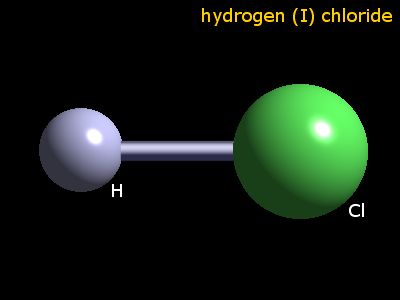Hydrogen chloride
- Formula: HCl
- Hill system formula: Cl1H1
- CAS registry number: [7647-01-0]
- Formula weight: 36.461
- Class: chloride
- Colour: colourless
- Appearance: gas
- Melting point: -114.2°C
- Boiling point: -85.1°C
- Density: 1187 kg m-3 (at freezing point)
The following are some synonyms of hydrogen chloride:
- hydrogen chloride
- hydrogen(I) chloride
- hyrochloric acid
- muriatic acid
- spirits of salt
The oxidation number of hydrogen in hydrogen chloride is 1.
Synthesis
Hydrogen chloride gas may be made in the laboratory by the reaction of concentrated sulphuric acid upon sodium chloride or by the by the reaction of concentrated sulphuric acid upon concentrated hydrochloric acid. In the latter case this involves adding hydrochloric acid to sulphuric acid and collecting the evolved hydrogen chloride gas. The yield is around 80%.
NaCl(s) + H2SO4 → HCl(g) + NaHSO4(s)
HCl(aq) + H2SO4 → HCl(g) + H2SO4(aq)
The first of these routes is used in industry, where temperatures of about 150°C are used. Crude hydrogen chloride gas is an important byproduct of the organic chemicals industries.
Solid state structure
- Geometry of hydrogen: 1 coordinate: terminus
- Prototypical structure:

Element analysis
The table shows element percentages for HCl (hydrogen chloride).
| Element | % |
|---|---|
| Cl | 97.24 |
| H | 2.76 |
Isotope pattern for HCl
The chart below shows the calculated isotope pattern for the formula HCl with the most intense ion set to 100%.
References
The data on these compounds pages are assembled and adapted from the primary literature and several other sources including the following.
- R.T. Sanderson in Chemical Periodicity, Reinhold, New York, USA, 1960.
- N.N. Greenwood and A. Earnshaw in Chemistry of the Elements, 2nd edition, Butterworth, UK, 1997.
- F.A. Cotton, G. Wilkinson, C.A. Murillo, and M. Bochmann, in Advanced Inorganic Chemistry, John Wiley & Sons, 1999.
- A.F. Trotman-Dickenson, (ed.) in Comprehensive Inorganic Chemistry, Pergamon, Oxford, UK, 1973.
- R.W.G. Wyckoff, in Crystal Structures, volume 1, Interscience, John Wiley & Sons, 1963.
- A.R.West in Basic solid state chemistry Chemistry, John Wiley & Sons, 1999.
- A.F. Wells in Structural inorganic chemistry, 4th edition, Oxford, UK, 1975.
- J.D.H. Donnay, (ed.) in Crystal data determinative tables, ACA monograph number 5, American Crystallographic Association, USA, 1963.
- D.R. Lide, (ed.) in Chemical Rubber Company handbook of chemistry and physics, CRC Press, Boca Raton, Florida, USA, 77th edition, 1996.
- J.W. Mellor in A comprehensive treatise on inorganic and theoretical chemistry, volumes 1-16, Longmans, London, UK, 1922-1937.
- J.E. Macintyre (ed.) in Dictionary of inorganic compounds, volumes 1-3, Chapman & Hall, London, UK, 1992.
